
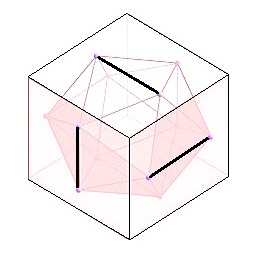
The New York Times reports today that Searle died on September 16, 2025.
See posts now tagged The Bracketing.
Claude in "Notorious" (1946) —
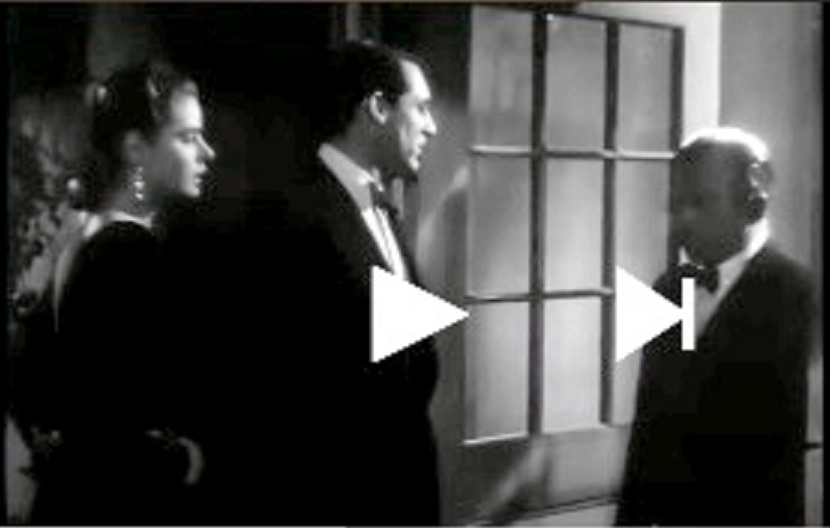
"I'm in with the in grid, I go where the in grid goes."

Midrash for storytellers . . .

This post was suggested by yesterday's update to
the "Analogy Between Analogies" post of October 6.
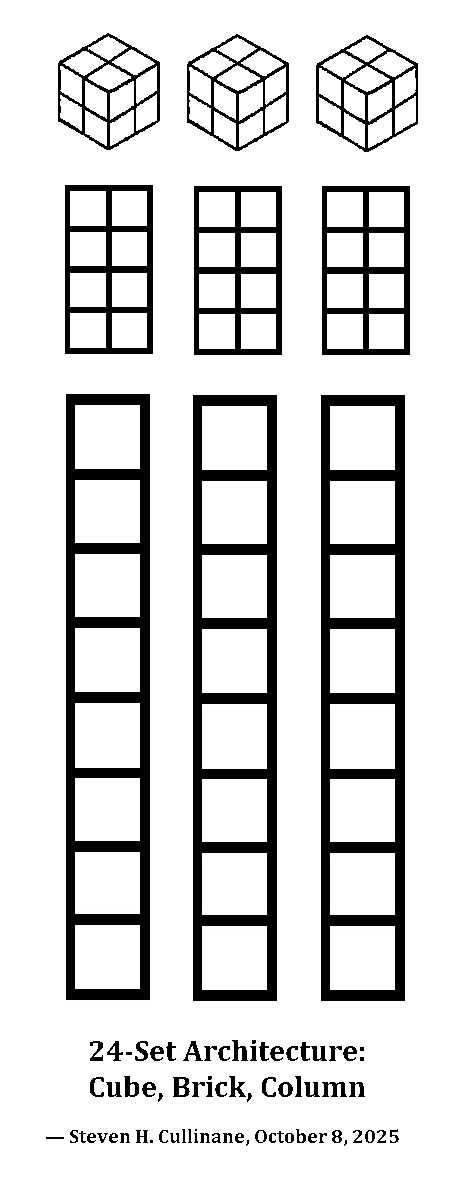
The reason for the above columns . . .
The action of S8 on the rows of an 8-row 3-column matrix
000
001
010
011
100
101
110
111
is intimately connected, via the 30 labelings of a Fano plane
and via the Klein quadric in PG(5, 2), with the action of a
group of order 322,560 on the 16 squares of a 4×4 array.
See Conwell, 1910 [1] and the Log24 tag 105 partitions.
1. Conwell, George M. “The 3-Space PG(3, 2) and Its Group.”
Annals of Mathematics, vol. 11, no. 2, 1910, pp. 60–76.
JSTOR, https://doi.org/10.2307/1967582.
For those who prefer narratives to mathematics: The Cubes.
How best to depict the 30 essentially different such structures is
not clear. See an update to yesterday's post on the structures.
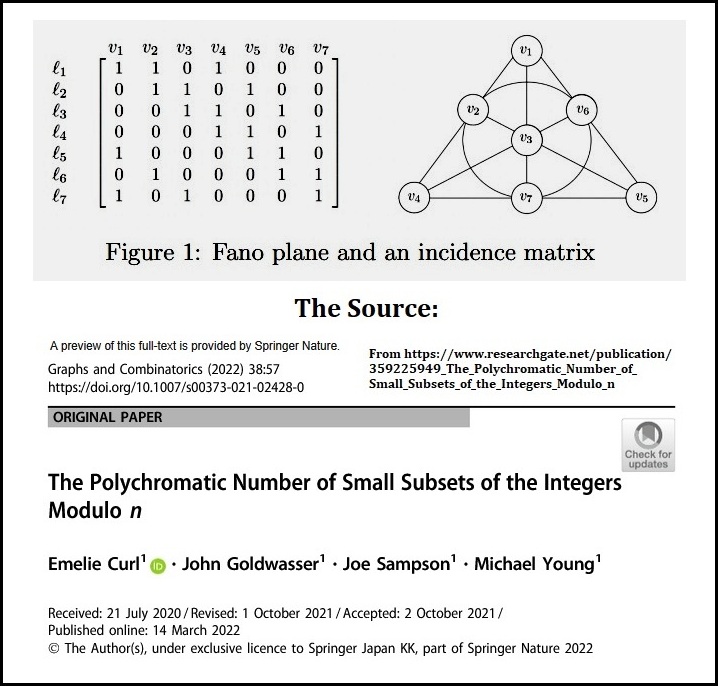
Consider . . .
A. The nontrivial analogy between the two parts of the well-known natural
15+15 partition of the 30 labelings of the Fano plane PG(2, 2)
B. The nontrivial analogy between the two parts of the well-known natural
15+15 partition of the 30 planes of the Klein quadric in PG(5, 2)
Are A and B nontrivially analogous? If so, how?
Update of 6:58 PM EDT Oct. 7 . . .
Hint:
Use as labels for PG(2, 2) points the seven nonzero vectors in the
3-space over GF(2), expressed as 001, 010, 011, 100, 101, 110, 111.
Then form three seven-digit vectors by taking the first, second, and third
digit in each 3-digit vector. View these seven-digit vectors as points of
the Klein quadric in PG(5, 2).
(Distinctness as labelings requires verification.)
Update of 1:35 PM EDT Oct. 7
The above incidence matrices are clearly distinct as matrices, but
whether they show the well-known 30 labelings that are structurally
distinct as labelings is not clear. There seems to be little discussion
of Fano-plane incidence matrices on the Web. One example of such
a matrix with a well-formed structure of cyclically shifted rows —

Related reading for fans of Bradbury's phrase
"patterning windows" and/or Aiken's phrase
"shadow guests" —
The Strong Law of Small Shapes (May 29, 2024).
The Hieronymus Bosch reference in a post yesterday morning
was suggested in part by the surrealistic drama "Changing Stations"
by one Victor Snaith. Snaith reportedly died at 77 on July 3, 2021.
He was a British professor of mathematics. Vide his obituary.
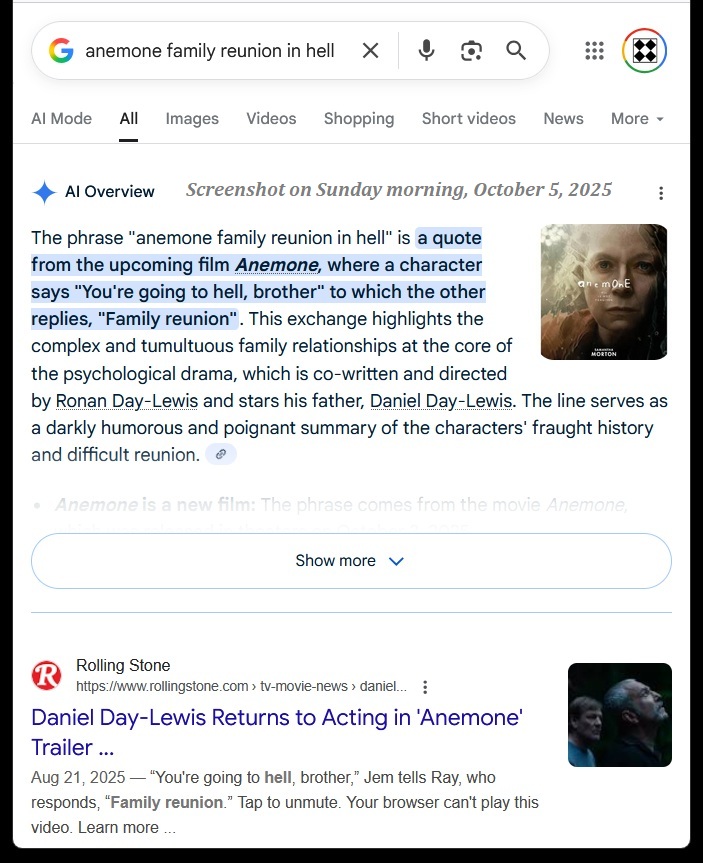
See also this journal on Snaith's reported death date, in other posts
tagged The Holy Field.
Some backstory: Snaith in Log24 posts tagged smallfield.
A mathematician, like a painter or a poet, is a maker of patterns.
If his patterns are more permanent than theirs, it is because
they are made with ideas.
— G. H. Hardy, A Mathematician's Apology (1940).
This post notes three uses of overlapping figures in mathematics.
The idea in each case is that of overlapping.
An old use of overlapping — probably well-known in ancient Greece:
A more recent use of overlapping — Venn diagrams:
My own personal use of overlapping —
half-circle patterns that led to the diamond theorem:
… who reportedly died at 91 on September 24, 2025 . . . .
A synchronology check yields Zadie Smith.
Scholium for St. Bonaventure —

A Log24 search —
http://m759.net/wordpress/?s=Bonaventure —
yields . . .
St. Bonaventure on the
Trinity at math16.com
and
A trinity:
Click on picture for further details.
|
Finite Geometry: A Unifying Framework "In essence, finite geometry, exemplified by the Cullinane diamond theorem, acts as a 'portal' that unveils profound mathematical structures underlying seemingly simple patterns, demonstrating the interconnectedness of geometry, algebra, combinatorics, and visual art, with significant implications for fields ranging from error-correcting codes to experimental design and signal processing." — NotebookLM AI on 18 September 2025 |

See as well a dies natalis on 18 September 2025 —

Posts now tagged Incipient Colorings.
Some related mathematics:
From this morning's Log24 post "The Black Van" —


Related reading:
http://m759.net/wordpress/?tag=the-jewels-of-life-and-death.
Related material suggested by news from later today . . .
The above-mentioned news . . .

"Holding onto the last of the summer fruit
on the last day of September…" — Lilyjcollins
This post was suggested by the arXiv date of a paper by
Peter J. Cameron on "asymmetric Latin squares" —
8 July 2015 — and by that date in this journal.
250928-Honey_Don't-driving-scene-at-about-0.24.52-
with-1.04.34-remaining-paused-at-about-6.30-AM-EDT
-250928.jpg
* Vide August 19, 2023.
Update, 10:15 AM Sept. 29 —
Another sort of Commedia mythspace:
today's update to the previous post.
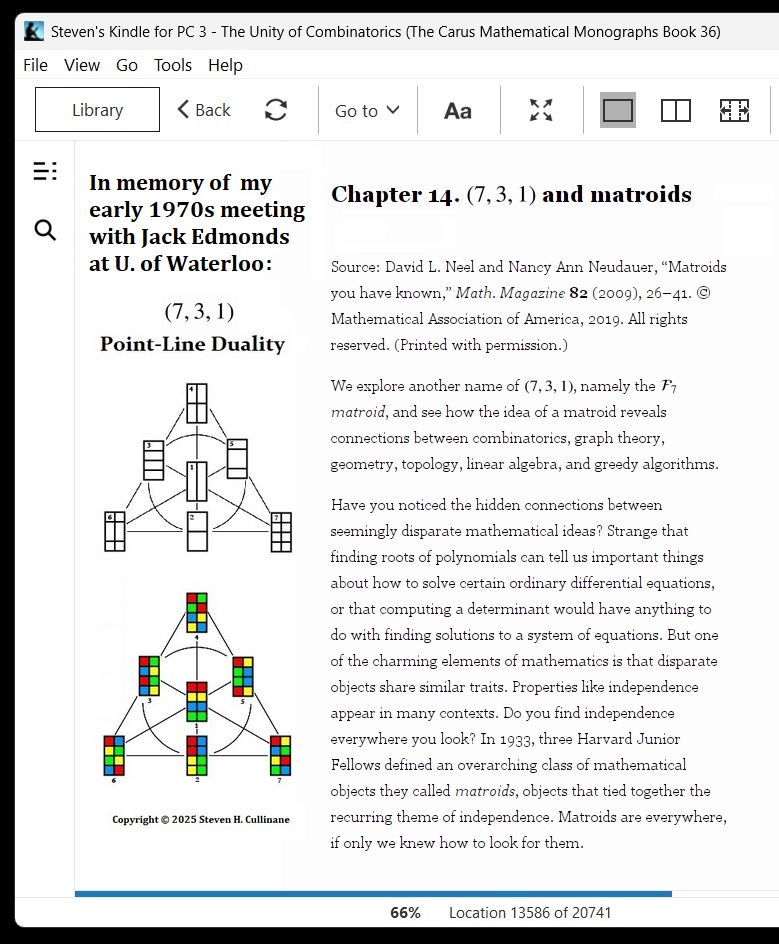
Update on Monday morning, Sept. 29, 2025 —
Related reading . . . Jack Edmonds in Wikipedia and . . .
Edmonds, Jack (1991), "A Glimpse of Heaven,"
in J.K. Lenstra; A.H.G. Rinnooy Kan; A. Schrijver (eds.),
History of Mathematical Programming – A Collection of
Personal Reminiscences, CWI, Amsterdam and North-Holland,
Amsterdam, pp. 32–54
The reported June 21, 2016, dies natalis of Ron Shaw
suggests a flashback . . .
http://m759.net/wordpress/?s="Ron+Shaw" —
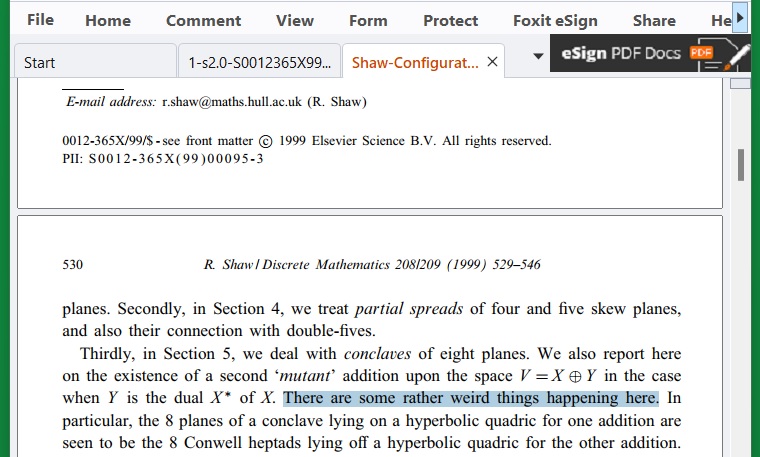
The Klein quadric as background for
the Miracle Octad Generator of R. T. Curtis —
Those who find Kubrick's black 2001 monolith too dark
may prefer a more colorful image, taken from yesterday's
post on the Klein correspondence —

![]()
![]()
And then there is . . . Rube Icon !

This post was suggested by the dies natalis of a figure from
the previous post, one L. S. Dembo.
A New York Times obituary on Sept. 21, 2025 —
"… he was an important, if not famous, figure . . . ."
Likewise . . . the figure 25/24, which in decimal form is
1.041666 . . .
"… the form, the pattern . . . ." — T. S. Eliot
The above fraction, or ratio, is a rational number. There are other
numbers that are not rational . . .
Other posts now tagged Mystery of O … and …

Cover design by Greg Stadnyk, available in an animated gif.

Illustration using Cullinane's four-color decomposition theorem —
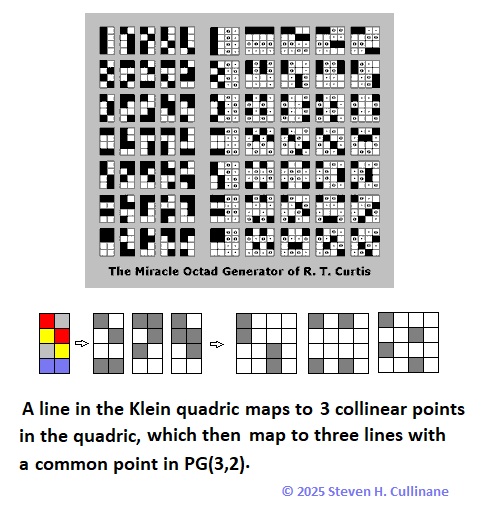
" … fare forward, voyager . . . ." — T. S. Eliot
"In my experience, every kind of writing requires
some kind of self-soothing Jedi mind trick, and,
when it comes to essay composition,
this rectangle is mine."
— Zadie Smith in The New Yorker, Sept. 22, 2025.
A mind trick that is perhaps less self-soothing —

The dimensional reduction above, from six affine dimensions over
GF(2) to four dimensions, is, like a similar reduction in the previous post,
done by considering only even-sized subsets, then considering as elements
only the boundaries between these subsets and their complements . . .
and the Galois (XOR) sums of those boundaties.
http://m759.net/wordpress/?s="six+dimensions+into+three"
The above link is for fans of Richard J. Trudeau's "Story Theory of Truth."
And then from pure mathematics, there is the reduction from eight dimensions
into six of Diamond Theory, in passing from the eight-dimensional affine space
over the two-element Galois field to the six-dimensional affine space used in
Diamond Theory to represent the five-dimensional projective space PG(5,2).
See other posts tagged Klein Space.
From a Log24 post of Oct. 22, 2015 —
Software writer Richard P. Gabriel describes some work of design
philosopher Christopher Alexander in the 1960s at Harvard:

The above 35 strips are, it turns out, isomorphic to
the 35 points of of the Klein quadric over GF(2).
Dialogue from the 2025 film "Fountain of Youth" —
EXTERIOR
– Mum!
– What?
– It's not maths. The pattern they found. It's not maths.
INTERIOR
– It's no good, Luke. The code's a brick wall.
– Then we've gone wrong somewhere. We're missing something.
– Hey.
– Hello.
– No. I don't wanna hear it.
– Sorry.
– Thomas.
– These seven digits aren't numbers. They're musical notes.
– What?
– Most universal language there is.


* See April 23, 2011.
Dialogue in Blade Runner: Black Lotus —
"Do you know who you're starting to sound like?"

“… Which makes it a gilt-edged priority that one of us
gets into that Krell lab and takes that brain boost.”
— American adaptation of Shakespeare’s Tempest , 1956
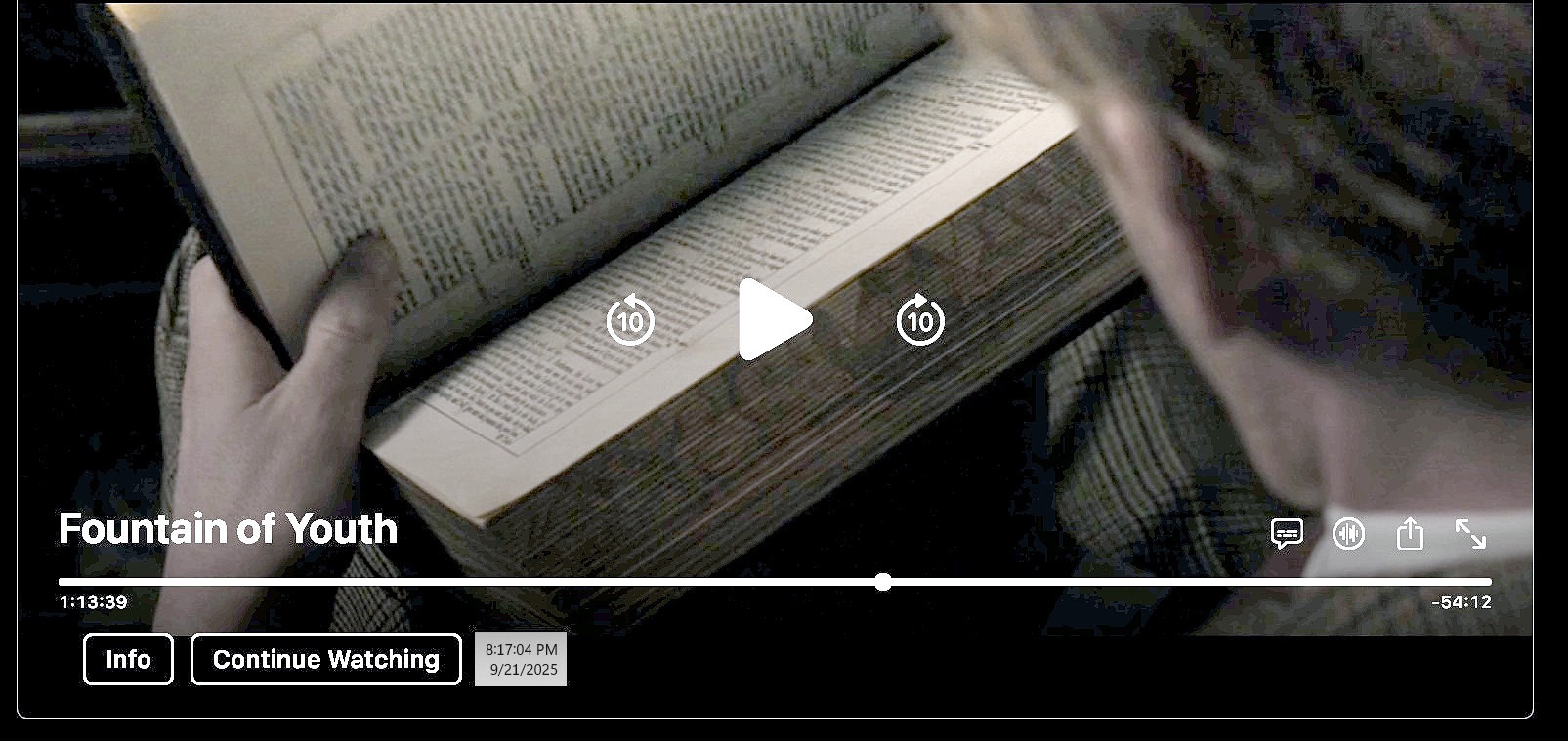
* Noun form of a Heinlein verb.
From a post of April 25, 2025 —

Zip! I was reading Schopenhauer last night.
Zip! And I think that Schopenhauer was right.
— "Pal Joey," 1940 musical by Rodgers and Hart
From a 2025 Apple TV+ film written by
James Vanderbilt —


http://m759.net/wordpress/?s=Matrix+Design
http://m759.net/wordpress/?s=Matrix+Resurrections
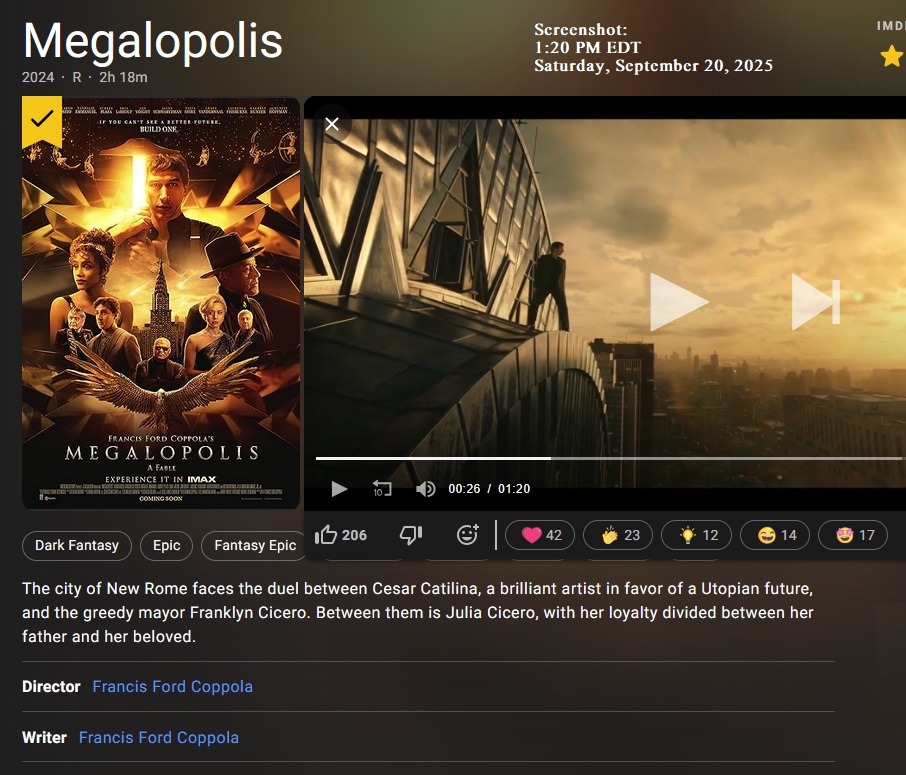
"Been there, done that." — John Wick
* See as well the above Klein date —
Dec. 19, 2021 — in this journal.
The relevant name here is not that of Jonathan Miller . . .
From the artificial intelligence at NotebookLM on Sept. 18, 2025 —
"Bridging Visual Art and Combinatorics
with Finite Projective Geometry
The Cullinane diamond theorem is a prime example,
originating from observations of symmetries in
traditional quilt designs and graphic art."
This is false.
The patterns in the diamond theorem originated from observing
superimposed 4×4 arrays of half-circles.
Vide http://finitegeometry.org/sc/16/overlay.html.
"Principal photography began on September 24, 2018, in Boston…."
— Wikipedia on the 2020 film Ava .
Also on September 24, 2018 —
Among possible meanings of beauty —
http://m759.net/wordpress/?s="Gideon+Summerfield"
"This mathematical framework links seemingly simple designs,
like quilt patterns, to complex concepts such as the Mathieu group M24,
the Miracle Octad Generator (MOG), and error-correcting codes."
Art from 1976 —
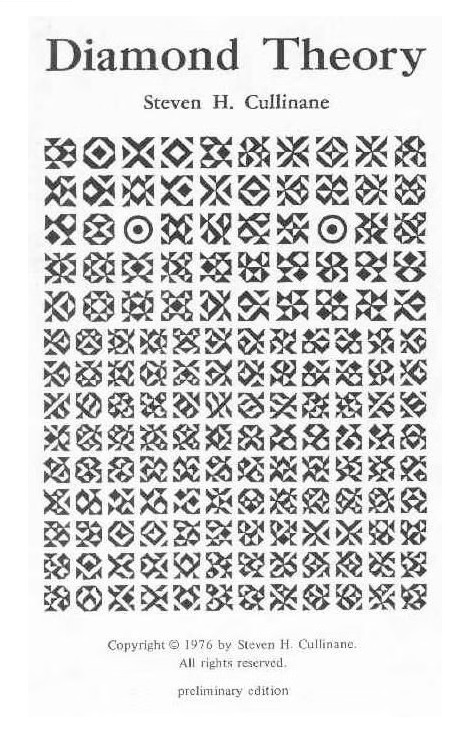
Art from 2025 —
A mathematician, like a painter or a poet, is a maker of patterns.
If his patterns are more permanent than theirs, it is because
they are made with ideas.
— G. H. Hardy, A Mathematician's Apology (1940).
In other art news . . .
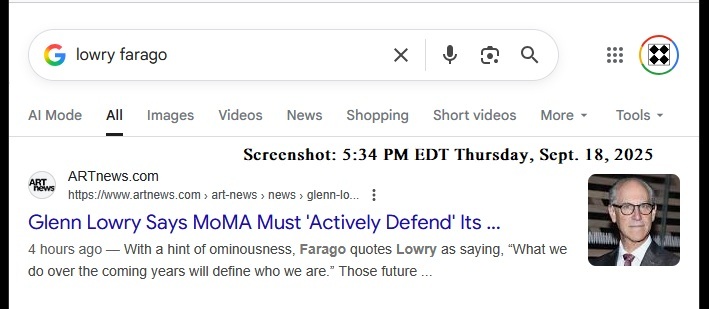
Images from https://shc7596.wixsite.com/website —


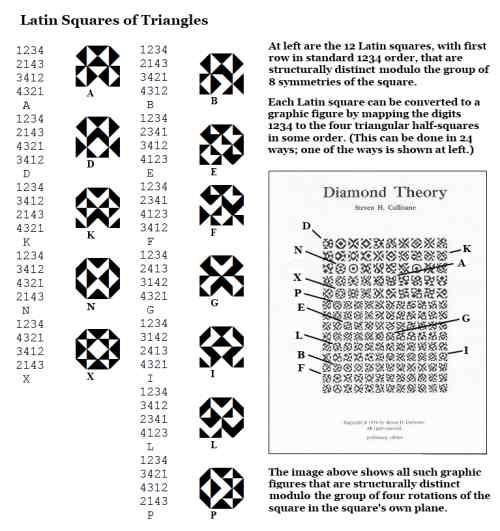
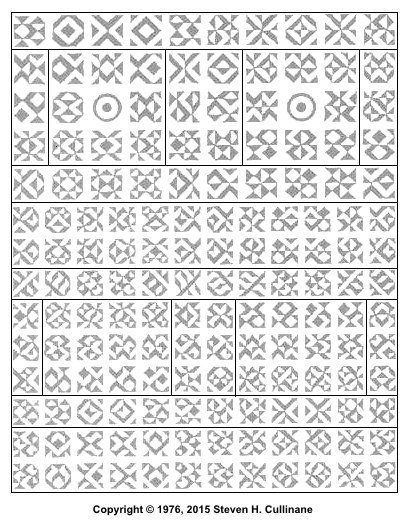

This post has been uploaded as a PDF to the NotebookLM
public notebook at https://notebooklm.google.com/notebook/
62ad8daa-277e-4fea-a680-9b209883f232.
A copy of the PDF is at
http://log24.com/log25/250918-Contrapuntal_Structure_
in_Latin_Squares-from-Log24.pdf.
|
Finite Geometry: A Unifying Framework by NotebookLM on September 18, 2025 Finite geometry serves as a powerful unifying framework that bridges diverse mathematical disciplines with artistic and practical applications, primarily by revealing deep underlying symmetries and structures. Here's how finite geometry achieves this unification:
In essence, finite geometry, exemplified by the Cullinane diamond theorem, acts as a "portal" that unveils profound mathematical structures underlying seemingly simple patterns, demonstrating the interconnectedness of geometry, algebra, combinatorics, and visual art, with significant implications for fields ranging from error-correcting codes to experimental design and signal processing. * This AI statement is false. See "Origin," Sept. 20, 2025. |
For those who prefer narratives to mathematics . . .
Abacus Conundrums (Monday, Sept. 15, 2025).
The number of subsquares in each large square
below is a prime power. Therefore each large square
is a Galois space.
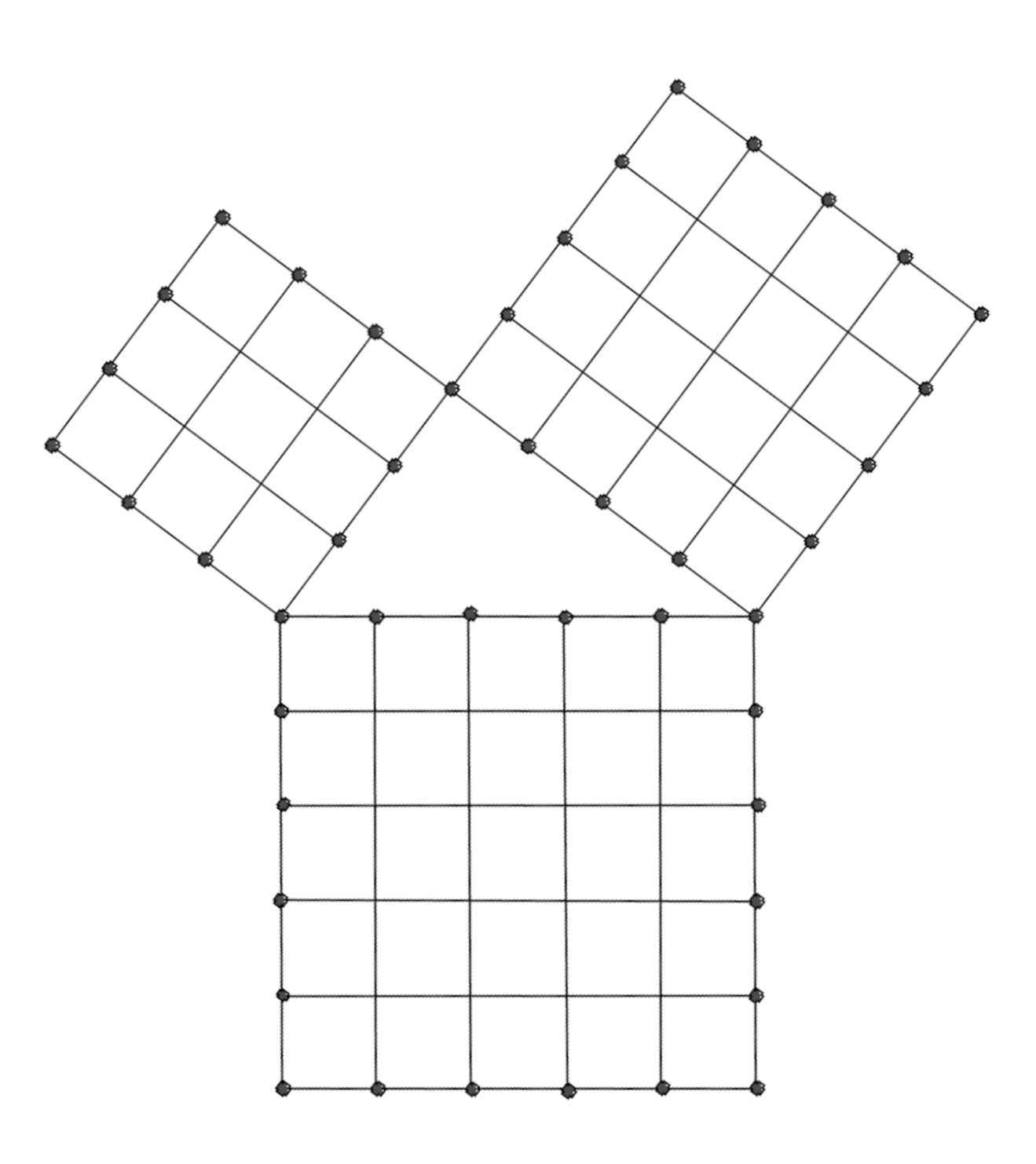
Related material at NotebookLM —
https://notebooklm.google.com/notebook/
62ad8daa-277e-4fea-a680-9b209883f232
and a copy at Log24.com —
http://log24.com/log25/
250917-'Diamond_Theory-NotebookLM'-notebooklm.google.com.pdf

* Vide a Log24 search for "Twin Pillars."
. . . and for Harlan Kane
|
From “Mimsy Were the Borogoves” (Padgett, 1943) —
…”Paradine looked up. He frowned, staring. What in— |
|
From City of Illusions (Le Guin, 1967) — All the top of the table, Falk now saw, was sunk several inches into a frame, and contained a network of gold and silver wires upon which beads were strung, so pierced that they could slip from wire to wire and, at certain points, from level to level. There were hundreds of beads, from the size of a baby’s fist to the size of an apple seed, made of clay and rock and wood and metal and bone and plastic and glass and amethyst, agate, topaz, turquoise, opal, amber, beryl, crystal, garnet, emerald, diamond. It was a patterning-frame, such as Zove and Buckeye and others of the House possessed. Thought to have come originally from the great culture of Davenant, though it was now very ancient on Earth, the thing was a fortune-teller, a computer, an implement of mystical discipline, a toy. In Falk’s short second life he had not had time to learn much about patterning-frames. Buckeye had once remarked that it took forty or fifty years to get handy with one; and hers, handed down from old in her family, had been only ten inches square, with twenty or thirty beads… . . . . A crystal prism struck an iron sphere with a clear, tiny clink. Turquoise shot to the left and a double link of polished bone set with garnets looped off to the right and down, while a fire-opal blazed for a moment in the dead center of the frame. Black, lean, strong hands flashed over the wires, playing with the jewels of life and death. “So,” said the Prince, “you want to go home. But look! Can you read the frame? Vastness. Ebony and diamond and crystal, all the jewels of fire: and the Opal-stone among them, going on, going out. |



Related material for Cairo Sweet . . .
CV books (by which I mean either
Curriculum Vitae or Clusterfuck Venue,
whichever pleases you more) —
C V

Related stupid math joke: "Girls just wanna have F1." — Song lyric

In lieu of an obituary . . .

The Magnum CNC lathe on the Web.
The lathe's beginning was in
North Warren, Pennsylvania.
Larson developed the lathe at Magnum
Machine, near his 105 S. State St. address.
Steven H. Cullinane helped him with the
software at Larson's S. State and Vine St.
workplace (the white roof below).
♫ "There's a chap I know in Mexico . . . ."
— Judy Garland
♫ "Could you use me?"
— Mickey Rooney
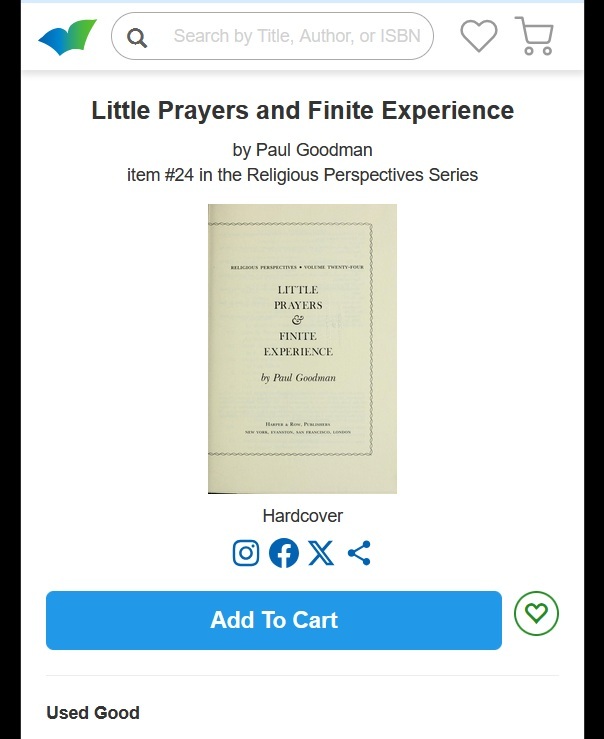
♫ "I used her, she used me,
but neither one cared."
— Bob Seger
"Patrick McGovern, the ‘Indiana Jones of Ancient Alcohol,’ Dies at 80"
— New York Times obituary today
His reported dies natalis was August 24, 2025, a Sunday.
See as well this journal on that date.


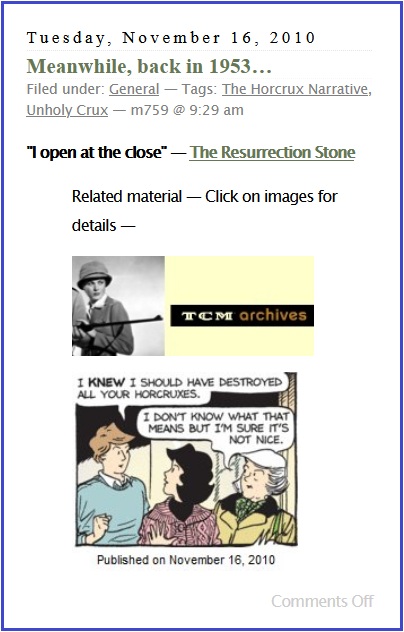
An August 31 Instagram post suggests . . .
The Graphic Part —
Galois Addition of Space Partitions
as the Exclusive Or (the XOR)
The Vocabulary Part —
From Cambridge, Mass., Where
Harvard Square Is Really a Triangle
A check of the dates in the search results shown in
the previous post yields an exercise . . .
Perhaps not.
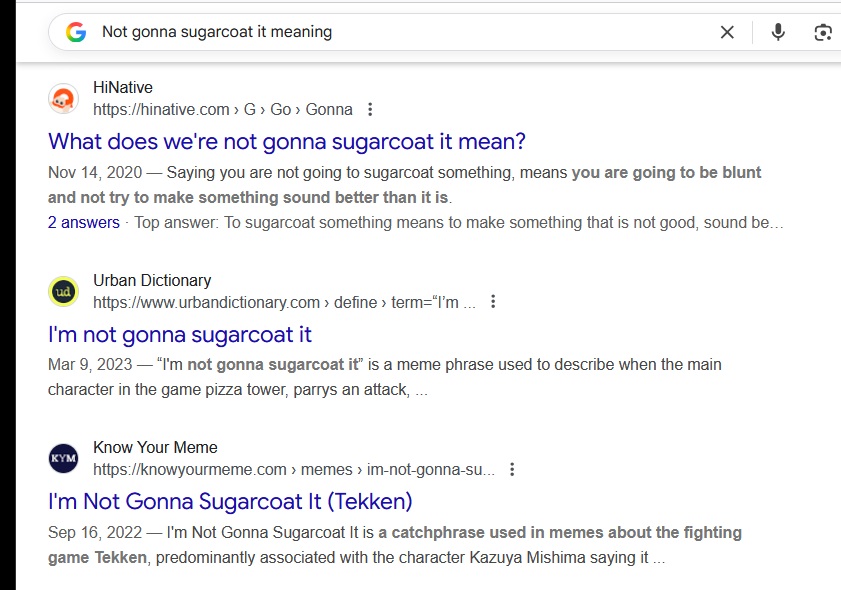
"Robert Langdon, Harvard professor of symbology,
arrives at the ultramodern Guggenheim Museum Bilbao…."
— Promotional book description at Amazon.com
"Continue a search for thirty-three and three."
— Sucker bait from Katherine Neville's masterpiece The Eight
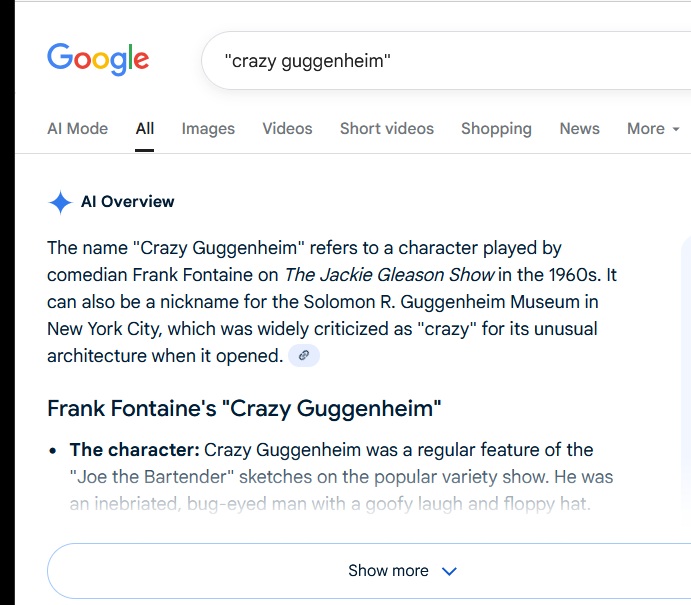
|
Cullinane Diamond Theorem and Symmetry in Finite Geometry by Microsoft Copilot on Wednesday, September 10, 2025 The Cullinane Diamond Theorem is a fascinating result in finite geometry that connects abstract mathematical structures with visual symmetry in graphic designs—like those found in quilts or tile patterns. 🧩 Core Idea At its heart, the theorem explores how finite projective geometry, specifically the projective space PG(3,2) (3-dimensional space over the finite field GF(2)), underlies the structure and symmetry of certain 4×4 arrays of tiles. 🔷 The Diamond Figure Imagine a 4×4 grid made of two-color diagonally-divided square tiles that form a picture of four diamonds. This picture is called the diamond figure D. A group G of 322,560 permutations acts on this figure. These permutations include: Swapping rows and columns Rearranging the four 2×2 quadrants 📐 The Theorem Every image of the diamond figure D under the group G has some ordinary or color-interchange symmetry. This means that no matter how you permute the tiles using the rules of G, the resulting pattern will always retain some form of symmetry. 🔭 Geometric Interpretation The 840 distinct patterns generated by G can be grouped into 35 structures, each corresponding to a line in PG(3,2). Each such line can be represented by a three-set of line diagrams, where each diagram is the binary sum of the other two. The 15 basic line diagrams correspond to the 15 points of PG(3,2). 🧠 Why It Matters This theorem shows how deep mathematical principles—like automorphism groups and projective geometry—can explain the symmetry in designs that have existed for centuries. It also links to advanced structures like the Miracle Octad Generator and even the Leech lattice, which plays a role in sphere packing and error-correcting codes. If you’re intrigued by the intersection of math and art, this theorem is a beautiful example of how abstract algebra and geometry can illuminate visual harmony. |
Material related to the quilts mentioned above,
from Bloomsday 2006 —
Today's news from Charlotte, North Carolina, suggests a look at
Language Game Venue and Log Lady Lines.
Excerpt —
| "But the first thing I felt when rereading Oliver’s work was frustration. Though almost uniformly straightforward and sincere, her poetry is vastly uneven in quality, demonstrating little thematic or stylistic growth over the long arc of her career. In the dullest poems, her trademark simplicity can seem like the result of lazy writing, bloated with abstractions that hurry the reader toward unearned epiphany. It wasn’t just that these poems didn’t require all my hard-won hermeneutic tools to be understood; it was that they seemed to actively thwart them, resisting my scalpel like polished stones." — Maggie Millner |
Tired of Maggie's farm?
Try Adrienne Rich on stonecutting —
|
Now, you intelligence
Be serious, because
— From the Adrienne Rich poem |
Cinematic Offering for Toronto Film Festival . . .
Guitar Case Study

Stiff competition . . .
Double Bass and a Nudie Suit

Powered by WordPress